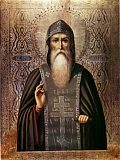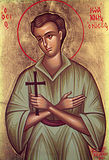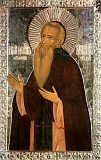

| Previous day | Next day |
| Old Style
May 27
|
Tuesday |
New Style
June 9
|
| First Week after Pentecost (Fast-free period). Tone 7. | No fast.
|
![]() Hieromartyr Therapontus, priest, of Sardis (3rd c.).
Hieromartyr Therapontus, priest, of Sardis (3rd c.). ![]() Translation of the relics of St. Nilus of Stolobny (1667).
Translation of the relics of St. Nilus of Stolobny (1667). ![]() St. John the Russian, confessor, whose relics are on the island of Euboea (1730).
St. John the Russian, confessor, whose relics are on the island of Euboea (1730).
Virgin-martyr Theodora and Martyr Didymus the Soldier, of Alexandria (304). St. Therapont, abbot, of Belozersk and Mozhaisk (1426). Translation of the relics (1472) of Sts. Cyprian, Photius, and Jonah, metropolitans of Kiev (1472). St. Therapontus, monk of Monza Monastery (Galich) (1597). St. Lazarus the Clarivoyant, hieroschemamonk of Pskov Caves Monastery (1824).
Martyr Julius the Veteran, at Dorostolum in Moesia (ca. 302). St. Michael of Parekhi, Georgia (8th c.-9th c.). St. Basil of Khakhuli, son of King Bagrat III of Georgia (11th c.). Hieromartyr Helladius, bishop (6th c.-7th c.). New Hieromartyr Therapontus, priest, of Sofia (Bulgaria) (1555).
Repose of Blessed Zina of Vetluga (1960).
Thoughts for Each Day of the Year
According to the Daily Church Readings from the Word of God
By St. Theophan the Recluse

Tuesday. [Rom. 1:1–7, 13–17; Matt. 4:25–5:13]
After the Lord’s baptism, when the Spirit descended upon Him in the form of a dove, He was brought down into the wilderness to be tempted. Such is the path common to all. Saint Issac the Syrian notes in one place that as soon as you taste grace-filled consolation, or receive some gift from the Lord—await temptations. Temptations conceal the brightness of grace from one’s own eyes which usually consume every good with self-opinion and self-exultation. These temptations are sometimes external—sorrows, humiliation; and internal—passionate thoughts, which purposely are released, like beasts unchained. Therefore, we must heed ourselves and strictly sort out what occurs with us and in us, to see why it is happening, and what obligations it brings.
Articles
 Hieromartyr Therapon the Bishop of SardisThe Hieromartyr Therapon, Bishop of Sardis suffered for Christ during the third century (the city of Sardis was in Lydia, Asia Minor). |
 St Photius the Metropolitan of KievSaint Photius, Metropolitan of Kiev and All Russia, was by birth a Greek from the Peloponnesian city of Monembasia (Malbasia). |
 St Jonah the Metropolitan of MoscowSaint Jonah, Metropolitan of Moscow and Wonderworker of All Russia, was born in the city of Galich into a pious Christian family. |







